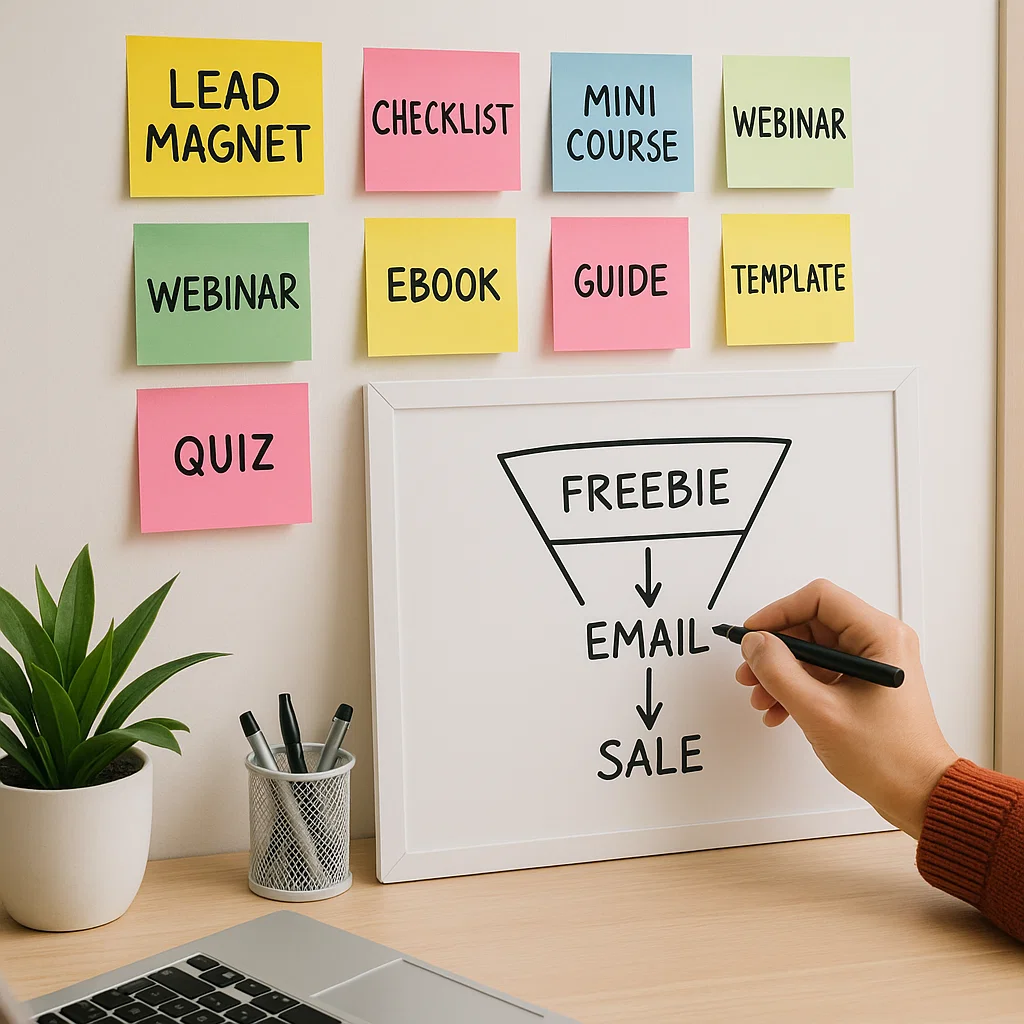Lead magnets are the unsung heroes of affiliate marketing. They are the bridges between curiosity and conversion, the reason someone hands over their email address instead of just scrolling away. Yet so many affiliates either skip them entirely or create something so generic that it collects dust instead of leads.
If you’ve ever wondered why some people grow email lists effortlessly while others struggle, the difference usually comes down to one thing: value that feels personal.
Let’s unpack what makes a lead magnet work, how to design one that your audience actually wants, and which types perform best in affiliate niches.
What a Lead Magnet Really Is
A lead magnet is a piece of free content or value that you give away in exchange for someone’s email address. Think of it as a taste test before the main meal. It should help your audience solve a small, specific problem related to your niche while naturally leading them toward a paid offer or affiliate recommendation.
Examples include checklists, short guides, quizzes, templates, or even mini video lessons. But the key word here is relevance. A generic “free guide” won’t work unless it hits a real pain point your reader is feeling right now.
A great lead magnet does three things:
- Solves a focused problem quickly.
- Creates a sense of trust and credibility.
- Aligns directly with the product or solution you promote.
If your lead magnet feels disconnected from your main offer, it may get sign-ups but very few sales afterward.
Why Lead Magnets Matter So Much in Affiliate Marketing
In affiliate marketing, trust is everything. Your reader is making buying decisions based on your word, your recommendation, and your ability to help them succeed.
A strong lead magnet does not just grow your list; it positions you as a helpful authority. It starts the relationship before the pitch.
Think about it this way: someone who joins your list after downloading a free checklist on “The 5 Tools Every Beginner Affiliate Needs” is far more likely to engage with your later emails about automation tools, autoresponders, or funnel builders. They already see you as a guide.
Your goal is not to create any freebie. Your goal is to create a gateway, something that attracts the right audience, repels the wrong one, and sets the tone for future sales.
The 3 Most Common Lead Magnet Mistakes
Before we talk about what works, it’s worth noting what doesn’t.
- Too broad or too vague
If your lead magnet tries to solve everything for everyone, it ends up helping no one. “The Ultimate Guide to Online Success” sounds impressive but means nothing. Narrow it down. - Too much work to consume
People don’t want homework. They want quick wins. A 60-page eBook may sound valuable, but most readers will never open it. Try something snackable, something they can use in minutes. - No clear connection to the main offer
If your lead magnet is about “mindset” but your affiliate product is a landing page builder, you’re missing the bridge. The best lead magnets flow naturally into your offer.
Lead Magnets That Actually Convert in Affiliate Niches
Here are a few high-converting types that work across most affiliate spaces, especially if you personalize them to your brand and audience.
1. Quick-Action Checklists
People love clarity. A one-page checklist feels easy to use and instantly rewarding.
Examples:
- “7 Steps to Launching Your First Affiliate Campaign”
- “Affiliate Blog Setup Checklist”
- “Daily Routine for Consistent Affiliate Sales”
Create your checklist in Canva or Google Docs, export it as a PDF, and share it through your email opt-in.
2. Mini Training or Video Walkthrough
Show, don’t tell. A short video where you demonstrate how to use a tool, set up a funnel, or write a product review can be more engaging than any written guide.
Examples:
- “How I Set Up My First Automated Affiliate Funnel”
- “Three Simple Tricks to Boost Click-Through Rates”
You can record your screen using Loom or OBS Studio, upload it to YouTube Unlisted, and share the link after sign-up.
3. Templates and Scripts
People love shortcuts. Templates and scripts save time and reduce the fear of getting it wrong.
Examples:
- “Affiliate Email Swipe Pack: 5 Copy-and-Paste Sequences for Beginners”
- “Proven Blog Post Template for Affiliate Reviews”
- “DM Scripts to Promote Your Affiliate Links Without Sounding Salesy”
Make sure to customize your templates with your own tone and personality. Authenticity converts better than perfection.
4. Tools and Resource Lists
Instead of teaching everything, simply share what you use. Resource lists convert well because they include multiple affiliate links without feeling promotional.
Examples:
- “My 10 Favorite Tools for Affiliate Marketers”
- “Affiliate Marketing Starter Kit: Tools You Need to Begin”
- “The Software Stack Behind My Passive Income System”
You can link to your affiliates through Pretty Links or ThirstyAffiliates to make the URLs cleaner and track clicks.
5. Quizzes and Self-Assessments
Quizzes create engagement and curiosity. They make the user participate, which builds more emotional investment before you even pitch a product.
Examples:
- “Which Affiliate Strategy Fits Your Personality?”
- “Find Your Perfect Side Hustle Match”
- “Are You Ready for Passive Income?”
You can build simple quizzes for free using Interact or Typeform.
Each result can recommend a different affiliate product based on the user’s answers, which makes the experience feel personalized.
How to Deliver Your Lead Magnet
Once you create your lead magnet, set up a simple delivery system. You don’t need fancy software to start.
- Create a landing page.
Use ConvertKit, LeadsLeap, or Systeme.io to build a clean, no-distraction opt-in page. - Automate delivery.
After someone signs up, your email tool should send the file automatically. Add a friendly message like:
“Thanks for joining! Here’s your free checklist, you’ll also get a few emails over the next week with tips to help you use it.”
- Follow up with value.
Use your next few emails to teach, not just sell. Build trust before introducing your affiliate link. - Add the magnet to multiple touchpoints.
Promote it on your blog sidebar, YouTube description, and social media bio. The more doors you create, the more people you invite in.
How to Know If Your Lead Magnet Is Working
Track these three things:
- Opt-in rate: How many people sign up compared to how many visit your page. Aim for at least 30%.
- Engagement rate: Are people opening and clicking your follow-up emails?
- Conversion rate: Are subscribers eventually buying through your links?
If you’re getting leads but no sales, tweak the alignment. Maybe the lead magnet attracts the wrong audience, or the next step in your funnel isn’t clear enough.
The Key Takeaway
Lead magnets are more than freebies. They are trust builders, list growers, and sales multipliers when done right.
Start small. Pick one problem your audience faces, solve it clearly, and connect it to a product that truly helps.
The goal is not to give away information, but transformation, even in a small way. When you help someone win once, they’ll come back to you for the next step.
Pick up your free copy of my 7-day Affiliate Jumpstart plan here:


